Microplastic – The Invisible Enemy
How worried should we be about microplastic? Beyond global warming, considered as the main adverse effect of human activity, the human race still has to fight with an enemy created by itself: plastic.
Seen, over a hundred years ago, when it was invented, as an innovative material for a wide range of industries and with multiple uses, plastic has become one of the enemies of the existence of life on Earth and not without cause.
Traces and components of plastic are currently found anywhere, from the peak of the highest mountain to the bottom of oceans, from the thickest forest to the driest desert.
Of course, plastic is not to blame that it is found everywhere, but it is the fault of humans and their neglect. We see everyday pictures, photos, videos and documentaries showing what ignorance does when we rather leave garbage everywhere, instead of taking it to the trash.
Wild animals tangled in fishing nets, birds that can no longer spread their wings because they are trapped in a plastic bag, turtles unable to eat because of a plastic straw stuck in their mouth etc. But this plastic is the visible enemy, which one can remove. No less dangerous is the invisible enemy – microplastic.
Eliminating or reducing pollution is one of the most debated topics in almost any part of the world and is undoubtedly one of the biggest challenges of the moment. Moreover, the European Union (EU) is, of all the political and economic organizations on Earth, the mouthpiece of environmental protection, elimination of pollution, use of only energy obtained from sources considered, sometimes erroneously or intentionally erroneously, non-polluting.
The European Commission (EC) classifies microplastics (particles smaller than 5 millimetres decomposed from plastic objects) into two types, primary and secondary. About the primary type says it comes, at a rate of 35%, from washing clothes made of synthetic materials, while other 28% is produced from the abrasion of car tires while driving. But not only car tires are to blame, but also those of scooters, bicycles, and virtually any machine or vehicle equipped with rubber wheels.
Electric or at least hybrid cars are seen as means to reduce pollution, but they aren’t. The enthusiasm of electric cars apostles is however appeased by researchers, who say that even these redemptive vehicles will pollute with microplastic from brakes and tires. Of course, new standards will be sought for the production of tires, but the movement that supports the elimination of private cars has more and more supporters.
In 2015, MEPs called for measures to reduce or even eliminate factories of clothes from synthetic materials, but given that the issue of plastic pollution is global, China or India should also be persuaded to join this objective. But it seems something more difficult to do than issuing a new European directive.
Secondary microplastics come from the degradation of plastic objects such as bags or bottles (PETs) of water or juice. Most microplastics in the world’s oceans are caused by these objects. There are also plastics deliberately introduced in some products, such as shower gel, toothpaste, sunscreen or lipstick, or in various fertilizers used in agriculture, which also contribute 2% to global pollution with this type of material.
In fact, the European Chemicals Agency (ECHA) claims that these plastics intentionally added to various products cause an annual pollution of 36,000 tons of microplastics in the EU. The problem is that they penetrate even into the tissues and organs of animals, as well as into human bodies, and even into their bloodstream.
Moreover, last year ECHA proposed the elimination of these intentionally added microplastics within five years, and in June this year the Risk Assessment Committee gave the green light to this plan. Next year, Member States are expected to vote on this proposal, and the restriction on the use of added microplastics would come into force in 2022. The term may seem very short, given the sluggishness with which such a large bureaucratic body as the EU sometimes deals with some issues, but perhaps the explanation lies in the fact that there is already a replacement for these microplastics.
However, pollution with these substances is much higher than previously thought. A study conducted off the coast of the United Kingdom (by the way, London is the most polluted city with microplastics in the world), and the United States concluded that in the oceans there are 12 – 125 trillion plastic particles, not 5 – 50 trillion as previously thought. Ingested by marine animals, these particles inevitably reach the bodies of the species at the top of the food chain. In fact, every year 330,000 tons of microplastics arrive in the environment, and they contribute from 15% to 31% to plastic pollution globally.
No more, no less, people consume on average at least 50,000 microplastic particles per year and inhale a similar amount, and the actual number could be much higher, according to the first study of this kind conducted so far. Scientists estimate that an adult consumes about 50,000 microplastic particles a year, and a child about 40,000. However, the health impact of ingesting microplastics is still unknown. That is if these adults and these children do not drink water at all. Because if they drink water, the amount of microplastic ingested increases enormously. According to researchers’ studies, bottled water contains 22 times more microplastic than tap water. A person who drinks only bottled water would consume 130,000 particles per year from this source alone, compared to 4,000 for tap water.
In the absence of action, the outlook is not very exciting. It is estimated that by 2040 the world’s oceans will contain three times more plastic than at present. That is, 660 million tons compared to 165 million tons now, the equivalent of 50 kilograms of plastic for every square meter of beach. However, how can we get rid of this problem that we humans have created and that seems to have gotten out of hand? If we left it where we find it thrown in nature, the plastic would take up to 1,000 years to decompose, but with the risk of leaving behind the toxic substances from which it was made.
Some put their hopes in plastic-eating larvae, which are actually parasites of beehives. Others believe that recycling is the solution to stop the plastic pollution of the planet, but this is not a 100% infallible process either, because not every plastic can be recycled. We might hope that education will solve the problem or at least part of it, but it would be a far too risky bet for the entire planet. There is a chance to reduce plastic production, but it is expensive. If each company used the latest available technologies in its production processes, plastic pollution would be reduced by 80% by 2040. This would involve expenses of USD 600 billion, but without government subsidies it is hard to believe that companies will have that money.
Romania and plastic waste
Romania, a country where superpowers such as Germany export hundreds of trucks of plastic waste for sorting and recycling, stands out again. Beyond the fact that recycling leaves much to be desired, despite all the commitments made to Brussels, the Danube pours 4.2 tons of plastic into the Black Sea every day, i.e. over 1.5 million tons per year, and each cubic meter of water contains nine microplastic particles. And, for this reason, the Black Sea contains, after the Mediterranean Sea, most marine waste in the entire EU. 90% of this waste is plastic, and 85% of it is PET and disposable bags, according to the European Commission, which aims to completely eliminate plastic pollution of the seas by 2030.
Legislation to reduce pollution
Following the ban on thin and very thin plastic bags from January 1, 2019, the EU is trying to limit the production and marketing of other plastic products, in the hope that it will reduce pollution from these materials. The European Commission has also raised the issue of banning plastic or recycled plastic packaging, but the measure could be too drastic for the EUR 10 billion market of production of these plastic items. But it is complicated or even impossible to reduce plastic pollution as long as you continue to produce that plastic. The same is true with the attempt to reduce pollution caused by cars. That is, there is already a protest vote on diesel, seen as a polluting fuel.
A kind of coal for car fuels. On the other hand, the major car manufacturers do not give up the manufacture of diesel engines. Then, how do we want to achieve our goal? Or, in fact, we don’t even want to achieve our goal, but just make some noise? However, other EU measures seem more feasible, namely the ban on disposable plastic items which, when thrown into the nature, make a significant contribution to microplastic pollution.
The list of these unwanted items consists of nine categories of disposable plastic products, namely ear sticks, cutlery (forks, knives, spoons, Chinese chopsticks), plates, beverage straws, beverage stirrers, balloon sticks or sticks supporting balloons, food containers made of expanded polystyrene (cans, lids), beverage containers made of expanded polystyrene (corks and lids), expanded polystyrene glasses, including their lids.
This decision was made by the EU in May 2019, and Member States have until 2021 to comply. If not, derogations may be granted at any time. Or fines.








